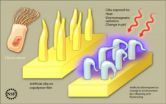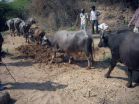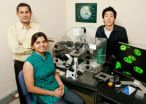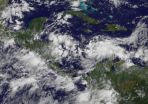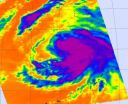(Press-News.org) RENO, Nev. – Like the little engine that could, the University of Nevada, Reno experiment to transform wastewater sludge to electrical power is chugging along, dwarfed by the million-gallon tanks, pipes and pumps at the Truckee Meadows Water Reclamation Facility where, ultimately, the plant's electrical power could be supplied on-site by the process University researchers are developing.
"We are very pleased with the results of the demonstration testing of our research," Chuck Coronella, principle investigator for the research project and an associate professor of chemical engineering, said. "The process to dry the sludge to make it burnable for a gasification process, which could then be transformed into electricity, is working very well. This is an important step for our renewable energy research, processing about 20 pounds an hour of sludge in a continuous-feed system to produce about 3 pounds an hour of dried powder."
The team of researchers custom built the processing machine in a lab at the University and brought it to the plant for testing. It uses an innovative process with relatively low temperatures in a fluidized bed of sand and salts to economically produce the biomass fuel from the gooey sludge.
The new patent-pending, low-cost, energy-efficient technology is an experimental carbon-neutral system. The solid fuel it produces will be analyzed for its suitability to be used for fuel through gasification, and the refrigerator-size demonstration unit will help researchers determine the optimum conditions for a commercial-sized operation.
"The beauty of this process is that it's designed to be all on-site, saving trucking costs and disposal fees for the sludge," Victor Vasquez, a University faculty member in chemical engineering and collaborator, said. "It uses waste heat from the process to drive the electrical generation. It also keeps the sludge out of the landfill."
Estimates, which will be further refined through the research, show that a full-scale system could potentially generate 25,000 kilowatt-hours per day to help power the local reclamation facility.
The demonstration-scale project is a collaboration with the cities of Reno and Sparks, operators of the wastewater plant. The city councils signed an interlocal agreement recently to allow the research to integrate into their operation, providing space for the experiments, the dewatered sludge and other resources to help make the project a success.
"Economically, this makes sense," Coronella said. "Treatment plants have to get rid of the sludge, and what better way than to process it on-site and use the renewable energy to lower operating costs. This demonstration gives the University an opportunity to involve students in development of waste-to-energy technology, which ultimately will benefit the community. It's a win-win for everyone involved."
"Our next step is to do exactly what this dryer is doing on a much larger scale," he added. "We plan to demonstrate the technology at a scale 100 times larger, to convince investors and plant operators of the technology's viability."
The University's Technology Transfer Office, with assistance from the College of Business, is supporting the project with plans to make the system available to hundreds of communities around the country that operate water-treatment plants.
For example, there are approximately 700,000 metric tons of dried sludge produced annually in California municipalities, which would sustainably generate as much as 10 million kilowatt-hours per day.
The project is funded through the Energy Innovations Small Grant Program, the California Energy Commission and the Department of Energy. This phase of the project was selected for funding by the University's Tech Transfer Office under a DOE grant to support transferring technologies from the lab to practical application.
The project is one of many of the University's renewable energy research areas that have commercial potential to help Nevada's economy grow.
INFORMATION:
Nevada's land-grant university founded in 1874, the University of Nevada, Reno has an enrollment of more than 17,000 students. The University is home to one the country's largest study-abroad programs and the state's medical school, and offers outreach and education programs in all Nevada counties. For more information, visit http://newsroom.unr.edu.
University of Nevada, Reno, demonstrates successful sludge-to-power research
Experiment conducted at Truckee Meadows Water Reclamation Facility
2010-09-24
ELSE PRESS RELEASES FROM THIS DATE:
Groundwater depletion rate accelerating worldwide
2010-09-24
WASHINGTON– In recent decades, the rate at which humans worldwide are pumping dry the vast underground stores of water that billions depend on has more than doubled, say scientists who have conducted an unusual, global assessment of groundwater use.
These fast-shrinking subterranean reservoirs are essential to daily life and agriculture in many regions, while also sustaining streams, wetlands, and ecosystems and resisting land subsidence and salt water intrusion into fresh water supplies. Today, people are drawing so much water from below that they are adding enough ...
Cilia revolution
2010-09-24
University of Southern Mississippi scientists recently imitated Mother Nature by developing, for the first time, a new, skinny-molecule-based material that resembles cilia, the tiny, hair-like structures through which organisms derive smell, vision, hearing and fluid flow.
While the new material isn't exactly like cilia, it responds to thermal, chemical, and electromagnetic stimulation, allowing researchers to control it and opening unlimited possibilities for future use.
This finding is published in today's edition of the journal Advanced Functional Materials. The ...
Taking a new look at old digs: Trampling animals may alter Stone Age sites
2010-09-24
Archaeologists who interpret Stone Age culture from discoveries of ancient tools and artifacts may need to reanalyze some of their conclusions.
That's the finding suggested by a new study that for the first time looked at the impact of water buffalo and goats trampling artifacts into mud.
In seeking to understand how much artifacts can be disturbed, the new study documented how animal trampling in a water-saturated area can result in an alarming amount of disturbance, says archaeologist Metin I. Eren, a graduate student at Southern Methodist University, Dallas, and ...
High pressure experiments reproduce mineral structures 1,800 miles deep
2010-09-24
University of California, Berkeley, and Yale University scientists have recreated the tremendous pressures and high temperatures deep in the Earth to resolve a long-standing puzzle: why some seismic waves travel faster than others through the boundary between the solid mantle and fluid outer core.
Below the earth's crust stretches an approximately 1,800-mile-thick mantle composed mostly of a mineral called magnesium silicate perovskite (MgSiO3). Below this depth, the pressures are so high that perovskite is compressed into a phase known as post-perovskite, which comprises ...
Cancer-associated long non-coding RNA regulates pre-mRNA splicing
2010-09-24
CHAMPAIGN, Ill. — Researchers report this month that MALAT1, a long non-coding RNA that is implicated in certain cancers, regulates pre-mRNA splicing – a critical step in the earliest stage of protein production. Their study appears in the journal Molecular Cell.
Nearly 5 percent of the human genome codes for proteins, and scientists are only beginning to understand the role of the rest of the "non-coding" genome. Among the least studied non-coding genes – which are transcribed from DNA to RNA but generally are not translated into proteins – are the long non-coding RNAs ...
GOES-13 sees tropical depression 15 form in the south-central Caribbean Sea
2010-09-24
The fifteenth tropical depression of the Atlantic Ocean season has formed in the south-central Caribbean Sea, and the GOES-13 satellite captured its swirling mass of clouds and showers in a visible image today. Watches and warnings are already up for Central America.
At 2 p.m. EDT today, Sept. 23, Tropical Depression 15 had maximum sustained winds near 35 mph. It was located about 485 miles east of Puerto Cabezas, Nicaragua, near 13.9 North and 76.2 West. It was moving west at 15 mph, and had a minimum central pressure of 1007 millibars.
The government of Nicaragua ...
NASA sees important cloud-top temperatures as Tropical Storm Malakas heads for Iwo To
2010-09-24
NASA's Aqua satellite has peered into the cloud tops of Tropical Storm Malakas and derived just how cold they really are, giving an indication to forecasters of the strength of the storm.
The Atmospheric Infrared Sounder instrument, known as AIRS has the ability to determine cloud top and sea surface temperatures from its position in space aboard NASA's Aqua satellite. Cloud top temperatures help forecasters know if a storm is powering up or powering down.
When cloud top temperatures get colder it means that they're getting higher into the atmosphere which means the ...
NASA satellites help see ups and downs ahead for Depression Lisa
2010-09-24
Tropical Depression Lisa has had a struggle, and it appears that she's in for more of the same.
Infrared satellite imagery from the Atmospheric Infrared Sounder (AIRS) instrument on NASA's Aqua satellite shows that the convection (rapidly rising air that forms thunderstorms that make up a tropical cyclone) is increasing in Lisa. The convection is becoming a little better organized and stronger which is will make for some heavy rainfall over the northwestern Cape Verde Islands. It's also an indication that she may be strengthening back into a tropical storm today.
That ...
Team of researchers finds possible new genetic risk for Alzheimer's disease
2010-09-24
Researchers have identified a gene that appears to increase a person's risk of developing late-onset Alzheimer's disease, the most common form of the disease. The gene, abbreviated as MTHFD1L, is on chromosome six, and was identified in a genome-wide association study. Details are published September 23 in the journal PLoS Genetics.
The collaborative team of researchers was led by Margaret A. Pericak-Vance, PhD, Director of the John P. Hussman Institute for Human Genomics at the University of Miami Miller School of Medicine; Joseph D. Buxbaum, PhD, Department of Psychiatry, ...
Earth: Fixing Pakistan's water woes
2010-09-24
Pakistan is facing tremendous water issues. This summer's flooding has left millions of people without homes and without access to clean drinking water. But water issues - both quantity and quality - are not new to this strategically important country. Waterborne diseases account for 30 percent of all deaths in Pakistan, and kill some 250,000 children each year. Per capita water availability in Pakistan is less than one-ninth of what it is in the U.S. And what's more, researchers say if Pakistan doesn't manage its water resources differently, it's going to actually run ...
LAST 30 PRESS RELEASES:
First Editorial of 2026: Resisting AI slop
Joint ground- and space-based observations reveal Saturn-mass rogue planet
Inheritable genetic variant offers protection against blood cancer risk and progression
Pigs settled Pacific islands alongside early human voyagers
A Coral reef’s daily pulse reshapes microbes in surrounding waters
EAST Tokamak experiments exceed plasma density limit, offering new approach to fusion ignition
Groundbreaking discovery reveals Africa’s oldest cremation pyre and complex ritual practices
First breathing ‘lung-on-chip’ developed using genetically identical cells
How people moved pigs across the Pacific
Interaction of climate change and human activity and its impact on plant diversity in Qinghai-Tibet plateau
From addressing uncertainty to national strategy: an interpretation of Professor Lim Siong Guan’s views
Clinical trials on AI language model use in digestive healthcare
Scientists improve robotic visual–inertial trajectory localization accuracy using cross-modal interaction and selection techniques
Correlation between cancer cachexia and immune-related adverse events in HCC
Human adipose tissue: a new source for functional organoids
Metro lines double as freight highways during off-peak hours, Beijing study shows
Biomedical functions and applications of nanomaterials in tumor diagnosis and treatment: perspectives from ophthalmic oncology
3D imaging unveils how passivation improves perovskite solar cell performance
Enriching framework Al sites in 8-membered rings of Cu-SSZ-39 zeolite to enhance low-temperature ammonia selective catalytic reduction performance
AI-powered RNA drug development: a new frontier in therapeutics
Decoupling the HOR enhancement on PtRu: Dynamically matching interfacial water to reaction coordinates
Sulfur isn’t poisonous when it synergistically acts with phosphine in olefins hydroformylation
URI researchers uncover molecular mechanisms behind speciation in corals
Chitin based carbon aerogel offers a cleaner way to store thermal energy
Tracing hidden sources of nitrate pollution in rapidly changing rural urban landscapes
Viruses on plastic pollution may quietly accelerate the spread of antibiotic resistance
Three UH Rainbow Babies & Children’s faculty elected to prestigious American Pediatric Society
Tunnel resilience models unveiled to aid post-earthquake recovery
Satellite communication systems: the future of 5G/6G connectivity
Space computing power networks: a new frontier for satellite technologies
[Press-News.org] University of Nevada, Reno, demonstrates successful sludge-to-power researchExperiment conducted at Truckee Meadows Water Reclamation Facility

